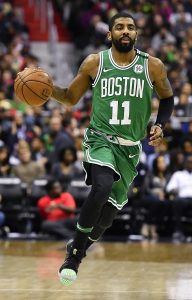Hoops Rumors is breaking down the 2018 offseason for all 30 NBA teams, revisiting the summer’s free agent signings, trades, draft picks, departures, and more. We’ll evaluate each team’s moves from the last several months and look ahead to what the 2018/19 season holds for all 30 franchises. Today, we’re focusing on the Phoenix Suns.
Signings:
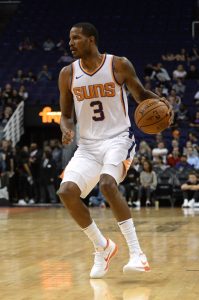 Standard contracts:
Standard contracts:
- Trevor Ariza: One year, $15MM. Signed using cap space.
- Jamal Crawford: One year, minimum salary. Signed using minimum salary exception.
- Two-way contracts:
- Non-guaranteed camp contracts:
Trades:
Draft picks:
- 1-1: Deandre Ayton — Signed to rookie contract.
- 1-10: Mikal Bridges — Signed to rookie contract.
- 2-31: Elie Okobo — Signed to four-year, $6.12MM contract. First two years guaranteed. Signed using cap space.
- 2-46: De’Anthony Melton — Signed to two-year, $2.37MM contract. Fully guaranteed. Signed using room exception.
- 2-59: George King — Signed to two-way contract.
Extensions:
- Devin Booker — Signed five-year, maximum salary rookie scale extension. Starts at 25% of the cap. Projected value of $158.05MM. Starts in 2019/20.
- Note: Starting salary will be worth 27.5% of the cap if Booker makes All-NBA Third Team, 28.5% for Second Team, and 30% for Third Team.
Departing players:
Other offseason news:
Salary cap situation:
- Used cap space; now over the cap.
- Carrying approximately $105.5MM in salary.
- $3.5MM of room exception still available ($949K used on De’Anthony Melton).
Check out the Phoenix Suns’ full roster and depth chart at RosterResource.com.
Story of the summer: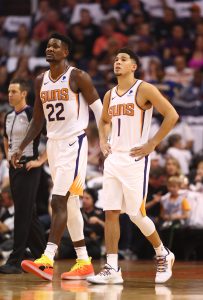
Devin Booker is still around. In fact, Booker signed a rookie scale max five-year extension this summer, which will make him a franchise cornerstone for years to come.
Beyond Booker and his sweet shooting stroke, the Suns look a whole lot different than they did last season. In fact, Phoenix had the biggest roster turnover of any team this offseason.
The Suns made some history in May by hiring Igor Koskokov, the first European-born head coach in NBA history. Koskokov spent 18 years in the league, most recently with the Jazz, before finally getting his big chance.
Draft night was guaranteed to be a pivotal moment in franchise history since the Suns had the top pick. They opted for center Deandre Ayton, who got his NBA career rolling with an 18-point, 10-rebound, 6-assist performance in his regular-season debut. Ayton could quickly develop into the one of the league’s premier big men, which would give the Suns a formidable inside-outside duo.
They swung a deal for another lottery pick, No. 10 selection Mikal Bridges, whom they project as their long-term solution at small forward. In the interim, Phoenix made a splash by signing Trevor Ariza to a one-year, $15MM contract.
Ariza’s contributions as a leader and winner will have a greater long-term impact than anything he does on the court this season. A sage, respected voice was needed in the locker room and they met Ariza’s price to provide it.
Ariza gave up a chance to play for a contender but he can re-enter the market next summer after cashing some big checks. He’ll put up some big numbers along the way and provide his usual solid defense, something the coaching staff can point out in the film room to the younger players.
Perhaps the most surprising personnel moves were made by owner Robert Sarver. During the latter stages of training camp, Sarver abruptly fired GM Ryan McDonough and several other executives. Typically, these types of decisions come right after a disappointing season rather than October in order to let the new regime shape the franchise as it sees fit. McDonough wasn’t going to win any popularity contests but the decisions he made this summer before clearing out his office will be felt for many years.
Read more
Key offseason losses:
Marquese Chriss was supposed to be the Suns’ starting power forward by now. Instead, the Suns gave up on him at the tender age of 21 by shipping him to the Rockets. With ample playing time available last season, Chriss actually regressed in his sophomore campaign, as his scoring average dropped from 9.2 PPG to 7.7 in comparable minutes. He graded out 76th among qualified power forwards in ESPN’s player efficiency rating.
Brandon Knight missed all of last season with a knee injury but he was expected to start at the point until McDonough shipped him with Chriss in the trade with Houston.
Journeyman forward Jared Dudley saw action in 48 games last season but didn’t have a future in Phoenix. He was shipped to the Nets in order to acquire a future second-rounder.
Point guard Elfrid Payton started 19 games last season after he was acquired from Orlando. Payton averaged 11.8 PPG and 6.2 APG but the Suns’ brass wasn’t convinced he was the answer at that spot and opted to let him walk in free agency.
Alex Len appeared in 69 games, including 13 starts, last season and posted averages of 8.5 PPG and 7.5 RPG. Len doesn’t fit the mold of an athletic, floor-stretching big man. Even if the Suns hadn’t drafted Ayton, they weren’t particularly interested in keeping Len around when he became a free agent.
Key offseason additions:
Beyond Ayton, Bridges and Ariza, the Suns made a few other significant changes to the roster.
Interim GM James Jones courted veteran guard Jamal Crawford on the eve of the regular season and convinced him to take a minimum-salary deal. It was a curious move by Crawford, who declined a $4.5MM player option with the Timberwolves to enter the market. He drew interest from some contenders but instead he’ll serve as a mentor and key reserve for Phoenix. Crawford averaged 10.3 PPG in 80 games with Minnesota.
Power forward Ryan Anderson saw his playing time steadily decline with the Rockets during the second year of a four-year, $80MM contract. Anderson was willing to reduce some of his guaranteed pay in order to get a fresh start with Phoenix. He’ll provide outside shooting to complement Ayton’s inside prowess.
Isaiah Canaan re-signed with the Suns. He joined in mid-December last season and appeared in 19 games before suffering a season-ending ankle injury. He was subsequently waived but did his rehab with the team’s training staff. He emerged, at least in the short term, as the team’s starting point guard during training camp.
Outlook for 2018/19:
The Suns certainly won’t be an overnight sensation. They have a gaping hole at the point and their power forward spot remains in flux after some bad draft decisions by the previous regime. Phoenix will take its lumps but at least it appears to have moved out of tank mode.
The presence of quality veterans Ariza and Crawford will make them more competitive but if they don’t finish last in the Pacific Division, it will only be a product of the Kings being even worse. The long-term picture is considerably brighter. Ayton and Booker give them All-Star level pieces to build around.
Ayton could easily justify his status as the top pick by winning the Rookie of the Year award. He’ll make the team a lot more fun to watch, even if the win-loss record won’t change a great deal.
Salary information from Basketball Insiders was used in the creation of this post. Photos courtesy of USA Today Sports Images. Luke Adams contributed to this post.
 Standard contracts:
Standard contracts:
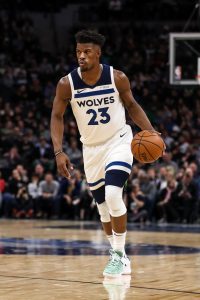
 Standard contracts:
Standard contracts:

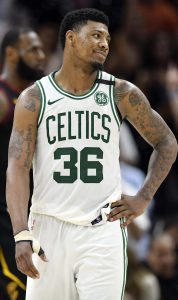 Standard contracts:
Standard contracts:
